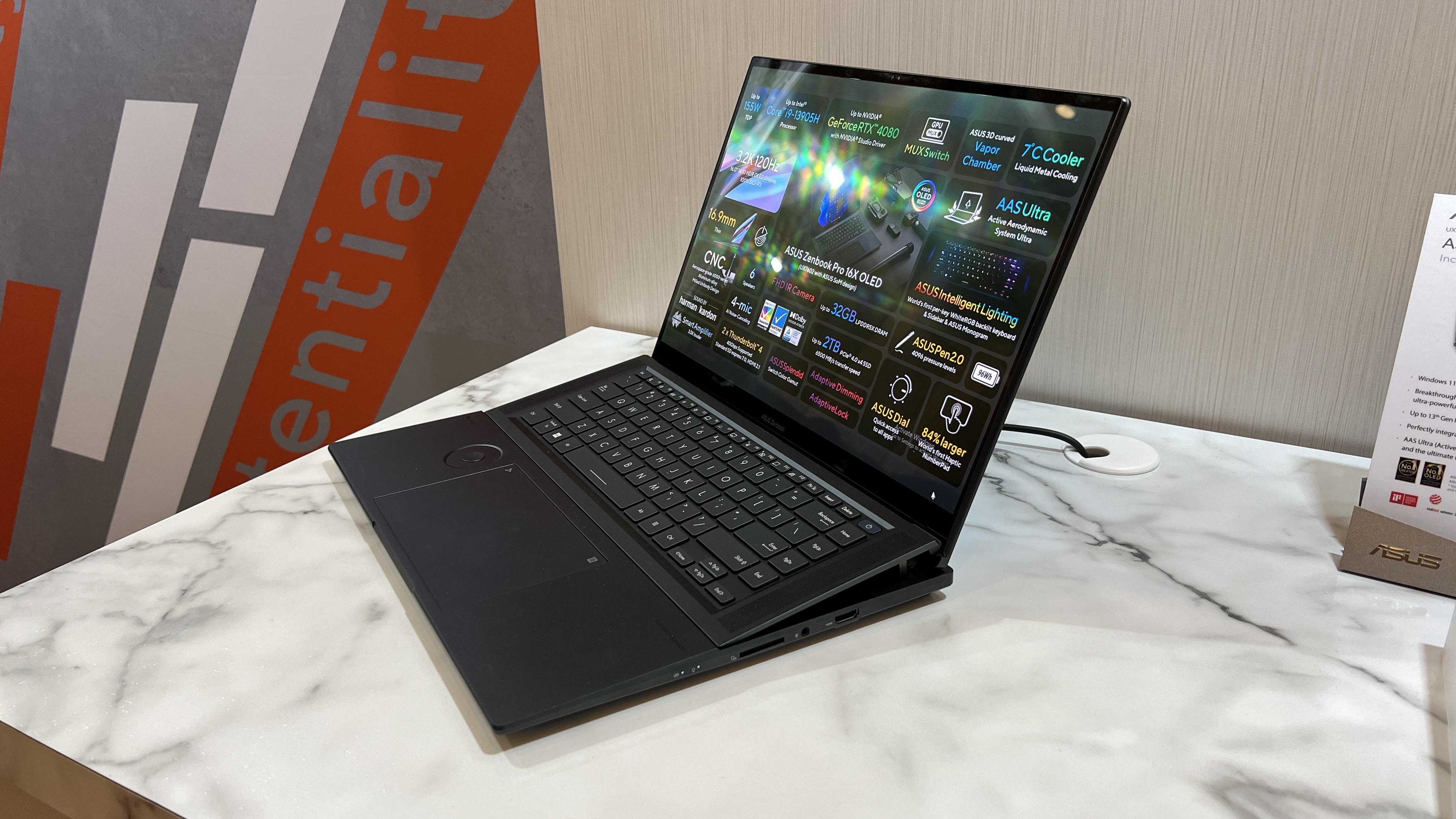Asus' 2023 Creativity Laptops Include Glasses-Free 3D, OLED
The company also introduced premium Zenbook and TUF Gaming laptops.
For the last few years, Asus has been building OLED into almost every machine in its productivity lineup. This year, it's starting to add glasses-free 3D.
Two machines, the ProArt Studiobook 16 3D OLED and the Asus Vivobook Pro 16X 3D OLED. will each come with a 16-inch, 16:10 screen with a 3200 x 2000 resolution at 120 Hz. Each can go into a "Spatial Vision" mode, which splits that resolution between your eyes.
I had a chance to try the screen on a Studiobook ahead of CES, and it does work. I could manipulate 3D objects, like a model of a dinosaur, and watch 3D movie trailers. I could, however, sense myself getting a bit headachey (we've had that issue with these types of screens before), so hopefully the final version is a bit smoother. I could see this potentially helping some professionals who work with 3D models to be used in 3D spaces, but this will also mean that the software they use will need to support this kind of display.
When you're not using Spatial Vision, you can turn it off, returning to a normal, high resolution OLED screen.
Both the Zenbook and Vivobook will use next-gen Intel Core HX series CPUs and Nvidia GeForce RTX GPUs. For the Studiobook, Asus is promising 150W of combined CPU and GPU performance, as well as up to 64GB of RAM and up to 8TB of PCIe 4.0 SSD storage. The Studiobook has a built in dial for use in some creative apps, while the Vivobook, with up to 64GB of RAM and up to 2TB of storage, has a more basic build with a touch-based dial on the trackpad.
A separate Vivobok Pro 16X OLED will have either the 3.2K 120 Hz OLED screen or a 2.6K, 165 Hz display, but without the 3D effect.
There are also four new members of the Zenbook family. The Zenbook 14 Flip OLED, Zenbook 14X OLED, Zenbook 14 Pro OLED and Zenbook Pro 16X OLED.
The Flips are 3.3-pounds convertible 2-in-1s using next-gen Intel Core P-series CPUs, with up to 16GB of LPDDR5-4800 memory and up to 1TB of PCIe Gen 4 SSD storage. The screen is a 14-inch, 2.8K 90 Hz OLED panel with TruBlack 500 certified HDR.
If you need something with some basic graphics might, the Zenbook 14X OLED will combine next-gen H-series Core CPUs with up to an Nvidia GeForce RTX 3050 laptop graphics card. It will go up to 32GB of LPDDR5 RAM and up to 1TB of storage, and mix two Thunderbolt 4 ports with USB Type-A 3.2 Gen 2 and HDMI 2.1. It has a 14.5-inch, 2880 x 1800 16:10 OLED touchscreen running at 120 Hz.
The Zenbook Pro 14 OLED uses an H-series Intel CPU and next-gen RTX laptop GPU using Nvidia Studio drivers, as well as a MUX switch to swap between integrated and discrete graphics. It will go up to 16GB of DDR5 with room to upgrade to 32GB, as well as up to 2TB of SSD storage. Asus stays its cooling will allow up to a 105-watt TDP on this system. The screen has the same specs at the 14 OLED.
The 16X OLED appears to be what a Zenbook Duo would be if there were no second screen. The keyboard still lifts up to allow more airflow, but there's just the one, 16-inch 3.2K, 120 Hz OLED panel.
Under the hood, things get more complicated. There's a next-gen Intel CPU (Asus didn't disclose which but it’s probably one of the new 13th gen mobile chips) with a "system on a module" design, putting the RAM on the CPU package. That will be paired with an unnamed Nvidia GeForce RTX laptop GPU. The system will have up to a 155W TDP, with cooling from a curved vapor chamber and liquid metal TIM. This model will have up to 32GB LPDDR5 RAM and up to 2TB PCIe 4.0 SSD storage, along with the Asus Dial, six speakers and an FHD webcam.
Asus TUF Gaming
Asus is also announcing the new TUF range, which is likely to best hit the price/performance sweet spot. The newest model is the TUF Gaming A16 Advantage Edition, which will pair a next-gen Ryzen 9 CPU with Radeon RDNA 3 graphics for a max TGP of 120 W. It will use DDR5 RAM and PCIe Gen 4 SSDs (exact specs aren't yet available), as well as a 16-inch display with a 16:10 aspect ratio up to QHD 240 Hz.
Get Tom's Hardware's best news and in-depth reviews, straight to your inbox.


The other TUF Gaming laptops are the F15 and F17 (Intel CPUs and Nvidia GPUs) and A15 and A17 (AMD CPUs and Nvidia GPUs). Both will go up to 140W max TGP and have up to QHD 240 Hz displays. The biggest difference outside of the CPU vendor is that the Intel version will use Thunderbolt 4 and the AMD option will use USB-4.
Asus told Tom's Hardware that pricing and more detailed specs for all of its laptops will come closer to their launches throughout Q1 and Q2 of this year.

Andrew E. Freedman is a senior editor at Tom's Hardware focusing on laptops, desktops and gaming. He also keeps up with the latest news. A lover of all things gaming and tech, his previous work has shown up in Tom's Guide, Laptop Mag, Kotaku, PCMag and Complex, among others. Follow him on Threads @FreedmanAE and BlueSky @andrewfreedman.net. You can send him tips on Signal: andrewfreedman.01
-
hotaru251 "3d" tried & died.Reply
thats why you dont see tvs with it anymore.
doubt niche crowd for it is worth making it (from a development/profit/sales standpoint)



